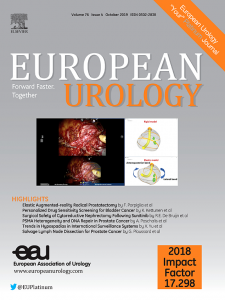Pelvic Lymph Node Dissection in Prostate Cancer: Evidence and Implications
IF 25.3
1区 医学
Q1 UROLOGY & NEPHROLOGY
引用次数: 0
前列腺癌盆腔淋巴结清扫:证据和意义
为什么要进行盆腔淋巴结清扫?在根治性前列腺切除术(RP)期间进行盆腔淋巴结清扫(PLND)已被国际指南推荐多年,包括以前版本的EAU-EANM-ESTRO-ESUR-ISUP-SIOG指南,用于分期目的和潜在的肿瘤学益处。扩展PLND (ePLND)模板比标准模板检测到更多的转移,因此当PLND被认为是必要的时,指南建议使用扩展PLND模板。ePLND分期信息可以理想地帮助术后患者选择plnd20多年来,基于术前信息的经验证的nomography已被用于个体化ePLND患者选择,以克服传统影像学(CT,磁共振成像[MRI])在敏感性方面的局限性。已经提出了不同的nomogram截止点,以最大限度地捕获可能患有pN1疾病的患者,同时试图避免所有患者的常规PLND。从历史上看,在2024年EAU-EANM-ESTRO-ESUR-ISUP-SIOG指南小组的立场上,由于ePLND能够准确地分期疾病,在审查现有证据和考虑风险/收益比后,重新考虑了先前“强烈”建议实施ePLND。2024年推荐的变化部分是由于决定推荐PSMA PET用于治疗前患者的分期评估。PSMA PET/CT是高度特异性的,但阴性预测值约为80%[9],[10],其中大多数遗漏的转移灶是小体积的
本文章由计算机程序翻译,如有差异,请以英文原文为准。
求助全文
约1分钟内获得全文
求助全文
来源期刊

European urology
医学-泌尿学与肾脏学
CiteScore
43.00
自引率
2.60%
发文量
1753
审稿时长
23 days
期刊介绍:
European Urology is a peer-reviewed journal that publishes original articles and reviews on a broad spectrum of urological issues. Covering topics such as oncology, impotence, infertility, pediatrics, lithiasis and endourology, the journal also highlights recent advances in techniques, instrumentation, surgery, and pediatric urology. This comprehensive approach provides readers with an in-depth guide to international developments in urology.
 求助内容:
求助内容: 应助结果提醒方式:
应助结果提醒方式:


